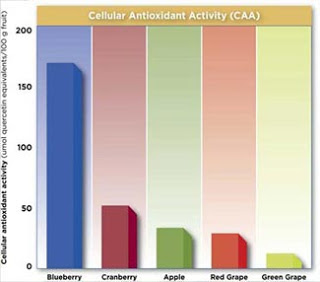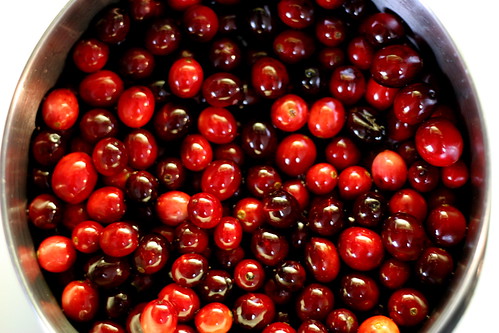Cranberries: 5 Things to Know About This Healthy, Colorful Fruit
In the fall, the cranberry’s heyday begins. Harvest season is marked by a sea of red for many regions, and while top cranberry producer Wisconsin is the state most recognized for its cranberry crop, Maine and parts of Canada also contribute to global cranberry production. Maine alone produces approximately 2 millions pounds annually, and this year, the state’s production may exceed 2.5, owing to few pest challenges and obliging weather conditions.
 Known for its colorful skin and flavor pizzazz, the cranberry is one of just three fruits native to North America, where it enjoys renown for its distinctly sweet-tart flavor and its irrevocable role in juices and as a holiday complement. The cranberry is also a contender when it comes to antioxidant content. While wild blueberries outperform them when it comes to measuring both antioxidant capacity and cellular antioxidant activity, cranberries pack their own health punch. Just by virtue of being a member of the high-antioxidant, free radical-fighting berry family, they are implicated in many benefits for the brain and cardiovascular system, and as a defense against some cancers. Eating cranberries is a key part of experiencing the rainbow of colors that nature provides to assist in disease prevention efforts.
Known for its colorful skin and flavor pizzazz, the cranberry is one of just three fruits native to North America, where it enjoys renown for its distinctly sweet-tart flavor and its irrevocable role in juices and as a holiday complement. The cranberry is also a contender when it comes to antioxidant content. While wild blueberries outperform them when it comes to measuring both antioxidant capacity and cellular antioxidant activity, cranberries pack their own health punch. Just by virtue of being a member of the high-antioxidant, free radical-fighting berry family, they are implicated in many benefits for the brain and cardiovascular system, and as a defense against some cancers. Eating cranberries is a key part of experiencing the rainbow of colors that nature provides to assist in disease prevention efforts.
If this intrepid berry has piqued your interest, your timing is right on target. Here are five things that will help you better understand and embrace a colorful fruit this season.
1) An Historical Remedy
It’s widely known that cranberries are a lauded home remedy for urinary tract infections. Research into whether cranberries have earned their reputation as a UTI treatment is ongoing, but studies have found that they do provide a defense against the bacteria responsible for UTIs, as do wild blueberries. The berry’s ability to prevent bacterial attachment may also provide benefits for ulcers, for example. Native Americans were well acquainted with this bacteria-preventing characteristic – they would crush up cranberries and use them as treatment for wounds.
2) Berries from the Bog

Cranberries are known for their unique growing and harvesting method in bogs. Cranberries actually grow on vines – they thrive in soft, marshy ground and grow naturally in areas that provide this environment. When cranberries ripen on the vines growing in these wetlands, farmers fill the area with water. A machine used to beat the water releases the cranberries from their vines, and they are left to float on the water’s surface, creating the crimson tide that we know as the cranberry bog. There, the floating berries are easy to collect and ship.
3) Scarlet, Frankly
Initially, cranberries are white (harvesting while the berries are still white explains white cranberries and white cranberry juice) and they take on their deep ruby color with ripening, thanks to anthocyanin, a phytonutrient that provides color and health benefits. Natural sunlight is the catalyst to increasing phytonutrient content in the cranberry – the more sun, the more powerful the berry’s health benefits. Anthocyanins, found in all berries, promote health by fighting cell damage and reducing inflammation, a risk factor in many health issues, including cardiovascular disease and cancer.
4) Synergy
This red berry has more than spunk – it has synergy. Synergy is nature’s way of “packaging” nutrients that results in big health benefits. It occurs when components within the same food, or components between different foods, work together in a way that is more powerful than their effects would be separately. This heightened nutritional value supports disease prevention efforts and other aspects of health, such as weight loss. Some recent studies indicate that cranberries eaten whole rather than consumed as a liquid, dried, or in supplement form, for example, allow a synergistic reaction that heightens their dietary impact. (It’s the same with other foods like wild blueberries, a fruit that lends itself to being consumed whole if you are looking for a healthy, easy-to-eat alternative.) It’s another reason that buying the whole fruit is best for health – the special nutritional power of berries the way nature created them simply can’t be replicated.
5) Beyond the Bird
It might be early in the season to think about stuffing your Thanksgiving bird, but that’s no reason to wait to start enjoying cranberries. Berries of all kinds complete the health picture every day of the year by providing superb nutrition. And, cranberries are an excellent way to enjoy red-colored foods as we strive to eat across the color spectrum. Start welcoming them in your non-holiday recipes right now, in a Cranberry Relish for starters, to use in everyday sandwiches and sides. Enjoy a Cranberry Almond Cinnamon Tart to add zing to a meal, or bake Oatmeal Cranberry Cookies for the kids. Keep the trend going with Creamy Cranberry Salad to take full advantage of this colorful fruit. And, remember that you can substitute frozen wild blueberries for cranberries in many recipes.
Want a pie that packs and antioxidant punch? Please your palate with a Cranberry and Wild Blueberry Pie. Healthy eating never tasted so good!
What other fruits are native to North America? One is the wild blueberry, of course, indigenous to Maine and parts of Canada. The other is the Concord grape, which traces its history to nearby Concord, Massachusetts.
Photo Credit: “Cranberry”
 Half Chinese
Half Chinese


